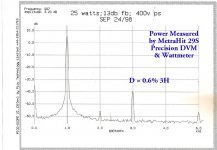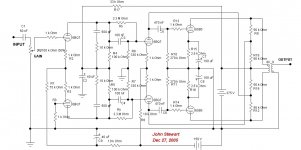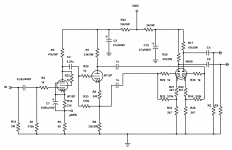Although post #39 is about the Brook 10C, still a warning about the schematic of the Brook 12A: The polarity of C3 is wrong and the filaments of the 2A3's are not grounded.
What would be a good OPT for that amp?A pair of 6080's using cathode bias on each tube is good for 25W.
It'd work, buy you'll have crap LF power. Use two and interleave them and the problem is solved though 🙂

You can also use two "OT" xfmrs in the Norman Crowhurst "Twin Coupled" arrangement, to get doubled primary voltage, inductance and power. With the 50% CFB you get with that scheme, any V reg. tubes (6080, 6AS7, 5998, 7236, 6336, 6528... ) will shine like 300Bs, from the inherent high linearity mode. (which V reg tubes aren't generally known for, although P-P helps a lot) ( I would suggest using the high gm 6528A for CFB mode, to keep the drive voltage reasonable )
Last edited:
Gonna take some heavy duty drive voltages for 100% cathode drive. TV Sweeps for drivers maybe. ( a little 6GF5 should do for 770V )
With 4x 6336A tubes you could just skip the OT.
With 4x 6336A tubes you could just skip the OT.
Last edited:
Unfortunately the 6528A is $68 from vacuumtubes.net, so with postage and duty from USA it will be a far from cheap outlay. 6336A are $48.
Yeah, big triodes are pricey. Although maybe comparable $$ to a new KT88 for the big V reg. tubes.
Vacuumtubes.net still lists the 21LG6A at $4, if they still have them. It's a Sweep tube, with 1100 mA peak rating, more than the 800 mA rating for the 6336A (full tube). There was an OTL thread on the forum not too long ago using the 21LG6A. For OTL I don't think it makes much difference if its not a triode, just a cathode follower anyway.
If one is going to use an OT, then a pair of most any of the TV Sweep tubes could get you 30 Watts in P-P. A little local N Fdbk and the Sweeps can do wonders. Some cap-less Sweeps: 12/6GE5, 12/6JN6, 21HB5A, 17KV6A, 6HJ5 (hard to find now)
Vacuumtubes.net still lists the 21LG6A at $4, if they still have them. It's a Sweep tube, with 1100 mA peak rating, more than the 800 mA rating for the 6336A (full tube). There was an OTL thread on the forum not too long ago using the 21LG6A. For OTL I don't think it makes much difference if its not a triode, just a cathode follower anyway.
If one is going to use an OT, then a pair of most any of the TV Sweep tubes could get you 30 Watts in P-P. A little local N Fdbk and the Sweeps can do wonders. Some cap-less Sweeps: 12/6GE5, 12/6JN6, 21HB5A, 17KV6A, 6HJ5 (hard to find now)
Last edited:
If you are looking at more than 15W, then the OPTs will make it hard to have a low cost solution, as the thread title? Just wondering if the scope has changed?
At 100% push pull cathode drive output . . . you may need to tie Individual 6.3V filament windings to the individual cathodes, one for each tube.
Example: A KT88 cathode to filament voltage maximum is 250V maximum.
Just imagine a push pull KT88 cathode follower amp, and only one 6.3V winding . . .
The Push cathode is headed to +250V, while the Pull cathode is headed to 0V.
The push pull primary is limited by the tubes to 500V differential, so only a low impedance primary will get you some power.
A beloved 6528A Dual section tube has a common filament, and the cathode to filament maximum voltage is +/- 300V.
One cathode can swing up +300V, and the other swing down -300V.
Etc.
Check your favorite tubes cathode to filament and filament to cathode maximum voltages (some are not equal from one polarity to the other polarity).
Then design a push pull cathode follower output stage.
Going to need some very large drive voltages from the driver, sounds like bootstrap circuit territory.
Your Mileage May Vary.
Example: A KT88 cathode to filament voltage maximum is 250V maximum.
Just imagine a push pull KT88 cathode follower amp, and only one 6.3V winding . . .
The Push cathode is headed to +250V, while the Pull cathode is headed to 0V.
The push pull primary is limited by the tubes to 500V differential, so only a low impedance primary will get you some power.
A beloved 6528A Dual section tube has a common filament, and the cathode to filament maximum voltage is +/- 300V.
One cathode can swing up +300V, and the other swing down -300V.
Etc.
Check your favorite tubes cathode to filament and filament to cathode maximum voltages (some are not equal from one polarity to the other polarity).
Then design a push pull cathode follower output stage.
Going to need some very large drive voltages from the driver, sounds like bootstrap circuit territory.
Your Mileage May Vary.
On the subject of pricey valves; a single Mullard ECC83 went on ebay for £1300 today. Has the valve market turned into stamp collecting?
Maybe the guy who bought the $2750 Carver Amp from China, a $1762 ( £1300 ) 12AX7 ought to fix it, right?
https://www.diyaudio.com/community/threads/malign-marketing-master-vs-cult-of-the-sinad.381972/
I bought all my tube stock years ago when they where like $1 to $3 each. 6HJ5 was $3. 17KV6A was $2.80 and 21HB5A or 12GE5 was $1. The best front end tubes you can still get for around $2 or $3. 6JC6A Raytheon (Japan), 6F12P, 6J49P..... Drivers: 12HL7 6197 6HZ8 6KV8 6LQ8 .....
https://www.diyaudio.com/community/threads/malign-marketing-master-vs-cult-of-the-sinad.381972/
I bought all my tube stock years ago when they where like $1 to $3 each. 6HJ5 was $3. 17KV6A was $2.80 and 21HB5A or 12GE5 was $1. The best front end tubes you can still get for around $2 or $3. 6JC6A Raytheon (Japan), 6F12P, 6J49P..... Drivers: 12HL7 6197 6HZ8 6KV8 6LQ8 .....
Last edited:
Hammond made an OPT for me similar to their 1650N but with half the impedance.What would be a good OPT for that amp?
The Hammond pn is H300429. But many other OPTs would work. Triodes are very tolerant of load impedance.
For SE something like Rl=4pp is a good tradeoff between max power & distortion.
This Amp was published May 1999 in Glass Audio. And on thi forum many times.
Later I realized it was possible to do the same without an UL tapped OPT. Here it is.
Attachments
Last edited:
As it happens my vers of Crowhurst's Twin Coupled Amp has been on the test bench for the last couple of weeks. When I get a chance from pushing snow & fixing things around the place I fire it up & do some tests. So attached are some of the results.You can also use two "OT" xfmrs in the Norman Crowhurst "Twin Coupled" arrangement, to get doubled primary voltage, inductance and power. With the 50% CFB you get with that scheme, any V reg. tubes (6080, 6AS7, 5998, 7236, 6336, 6528... ) will shine like 300Bs, from the inherent high linearity mode. (which V reg tubes aren't generally known for, although P-P helps a lot) ( I would suggest using the high gm 6528A for CFB mode, to keep the drive voltage reasonable )
This project was published Aug 2004 in AudioXpress magazine. And many times here on this forum.
Everything is 'off the shelf'. No boutique parts at all. The OPTs are Hammond 125E Universals. And CF driven PP 6LU8s.
The OPTs are a limiting factor, I had to series the secondaries. Purpose built OPTs would fix that as it did for Crowhurst.
Attachments
-
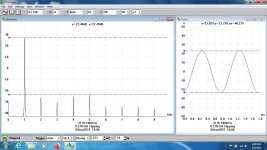 37 W !000 Hz Twin Coupled Amp.jpg154.8 KB · Views: 122
37 W !000 Hz Twin Coupled Amp.jpg154.8 KB · Views: 122 -
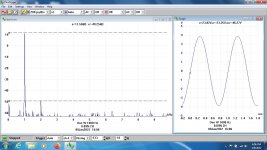 One W !000 Hz Twin Coupled Amp.jpg159.8 KB · Views: 94
One W !000 Hz Twin Coupled Amp.jpg159.8 KB · Views: 94 -
 SMPTE 10 W Twin Coupled Amp.jpg171 KB · Views: 87
SMPTE 10 W Twin Coupled Amp.jpg171 KB · Views: 87 -
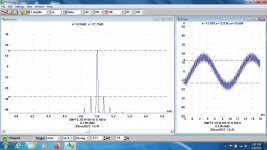 SMPTE 20 W Twin Coupled Amp.jpg166.7 KB · Views: 93
SMPTE 20 W Twin Coupled Amp.jpg166.7 KB · Views: 93 -
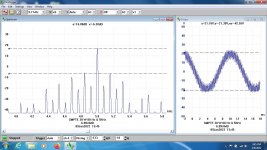 SMPTE 30 W Twin Coupled Amp.jpg177.8 KB · Views: 120
SMPTE 30 W Twin Coupled Amp.jpg177.8 KB · Views: 120 -
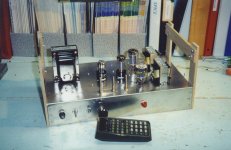 Twin Coupled Amp Front for RHS Veiwing.jpg195.6 KB · Views: 136
Twin Coupled Amp Front for RHS Veiwing.jpg195.6 KB · Views: 136
We went all thru that in another thread a few months ago. A ridiculous driving voltage is required.You can sidestep the linearity issue by running the output stage as cathode follower, too.
The driver becomes the challenge.
It'd work, buy you'll have crap LF power.
----------------------------
No problem for the low frequencies, that depends on a low rp, the 6AS7G & 6080 have that,
High frequency still a problem due to leakage inductance.
----------------------------
No problem for the low frequencies, that depends on a low rp, the 6AS7G & 6080 have that,
High frequency still a problem due to leakage inductance.
That all depends on voltages. If you use a 300V B+ you'll have crap bass. If you use 150V B+ it'll be fine. Also I have a driver that swings enough to drive it a cathode follower - and berfore you say "but where do I get 600V?" a quadrupler off 120V or a doubler from 230V... A tripler from 120V gets you close enough, too... Also the 47uF/600V cap is B43541B8476M000 from TDK but you could use a series pair... I redesigned my boards to use a pair to avoid a single source part.It'd work, buy you'll have crap LF power.
----------------------------
No problem for the low frequencies, that depends on a low rp, the 6AS7G & 6080 have that,
High frequency still a problem due to leakage inductance.
Attachments
Last edited:
Edcor offers a 25 Watt 1.6K to 16 Ohm OT now. Using 2 of them for the Crowhurst Twin gives you a 50 Watt 3.2K to 8 Ohm composite OT (secondaries paralleled). Unfortunately, their prices seem to have shot through the roof lately. $92 for one of them!
The OP said he had a 20 Watt OT for EL84 and another OT with lower Z. Post #30 shows 2 xfmrs in the rack mount chassis. Likely one is a power xfmr and the other the lower Z OT. Maybe its from an EL34 Amp. Which would explain the KT77 being attractive.
https://www.diyaudio.com/community/...l-amplifier-design.382074/page-2#post-6916971
-----------------------------------------------------------------------------------------
I'm going to have to start thinking about some clever work-arounds for OTs now too. I have a bunch of Signal Transformer 24 Watt DPC-xxx transformers
115V/115V to 60V/60V,
115V/115V to 20V/20V,
115V/115V to 8V/8V and
115V/115V to 6.3V/6.3V
that I got off Ebay years ago for cheap. Layer wound with good insulation from primaries to secondaries. The 115V/115V to 60V/60V could be used in reverse for B+. Circlotron mode allows any number of xfmrs to be series'd to get higher voltage windings, without huge distributed capacitance problems developing..
I was expecting this day would come. OTs --> $$$
Fortunately I already have a decent selection of Edcor OTs that are likely models to use with TV Sweep tubes too.

The OP said he had a 20 Watt OT for EL84 and another OT with lower Z. Post #30 shows 2 xfmrs in the rack mount chassis. Likely one is a power xfmr and the other the lower Z OT. Maybe its from an EL34 Amp. Which would explain the KT77 being attractive.
https://www.diyaudio.com/community/...l-amplifier-design.382074/page-2#post-6916971
-----------------------------------------------------------------------------------------
I'm going to have to start thinking about some clever work-arounds for OTs now too. I have a bunch of Signal Transformer 24 Watt DPC-xxx transformers
115V/115V to 60V/60V,
115V/115V to 20V/20V,
115V/115V to 8V/8V and
115V/115V to 6.3V/6.3V
that I got off Ebay years ago for cheap. Layer wound with good insulation from primaries to secondaries. The 115V/115V to 60V/60V could be used in reverse for B+. Circlotron mode allows any number of xfmrs to be series'd to get higher voltage windings, without huge distributed capacitance problems developing..
I was expecting this day would come. OTs --> $$$
Fortunately I already have a decent selection of Edcor OTs that are likely models to use with TV Sweep tubes too.
Last edited:
Philatelists have price guides. Tube-heads don't.Has the valve market turned into stamp collecting?
- Home
- Amplifiers
- Tubes / Valves
- Help deciding on a low cost 15-20 watt triode push-pull amplifier design
